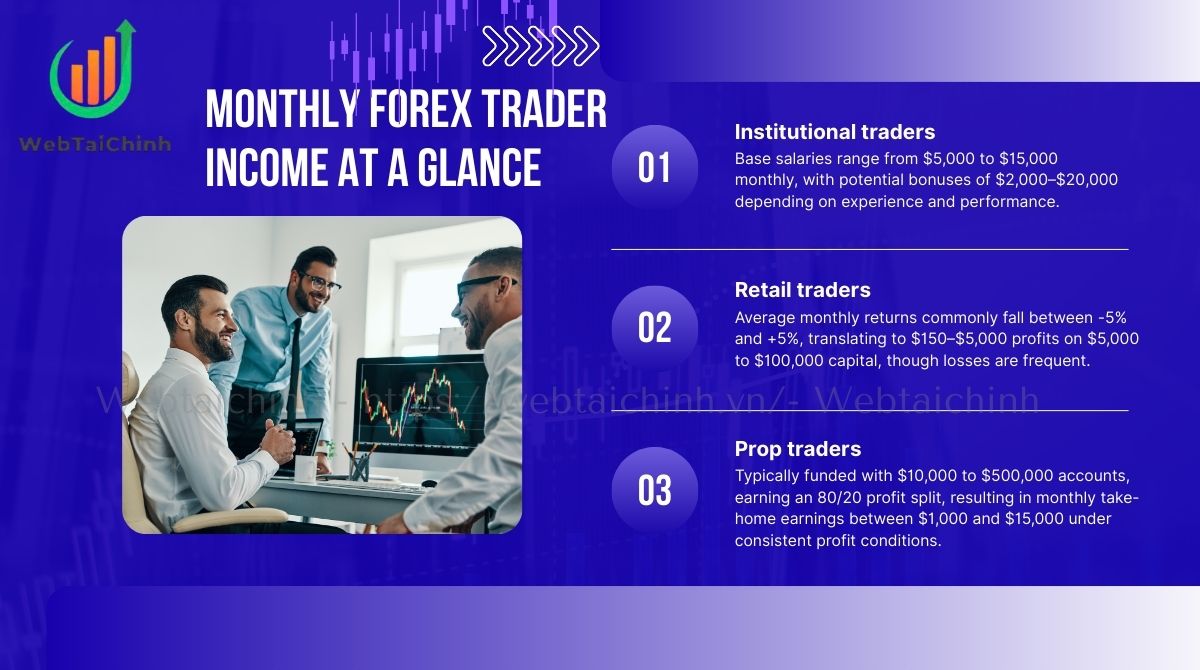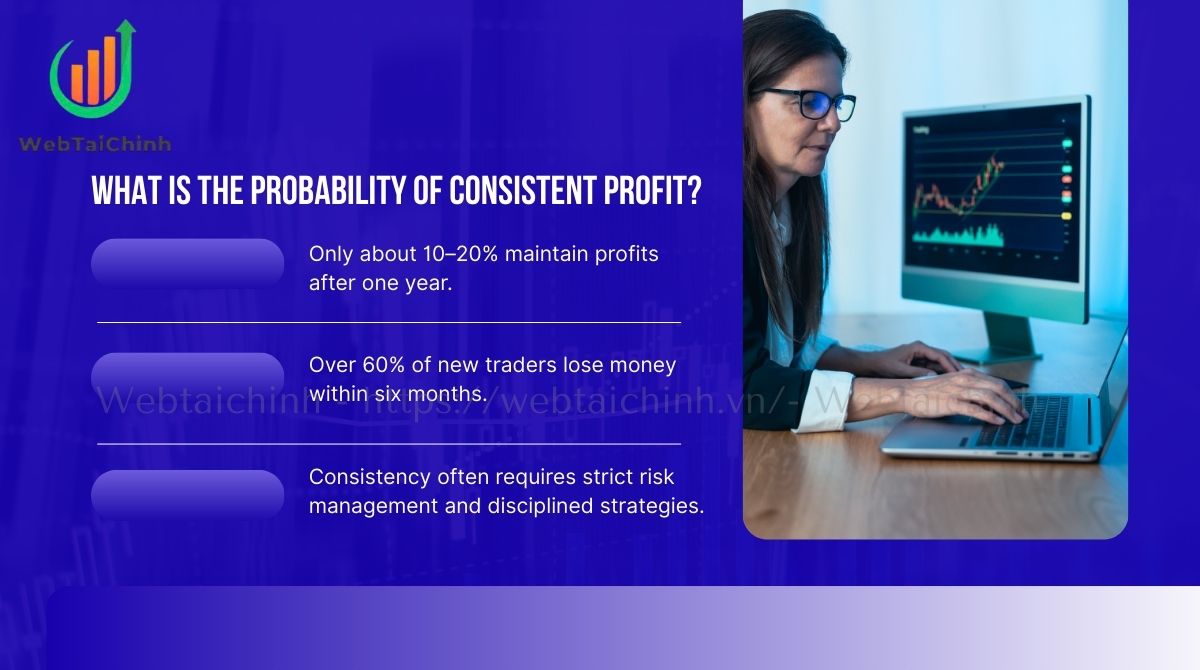Physical Address
304 North Cardinal St.
Dorchester Center, MA 02124
Physical Address
304 North Cardinal St.
Dorchester Center, MA 02124

Have you ever wondered how much do forex traders make a month and why the numbers vary so widely between traders? From institutional professionals earning stable salaries to retail and prop traders facing higher risks but also higher potential rewards, the reality is far from the “get rich quick” promises you often see online.
In this guide, we’ll break down realistic income ranges, key factors that influence monthly earnings, and examples that show what traders can actually expect in 2025.
Key takeaways:
When asking how much do forex traders make a month, the answer depends heavily on the trading path chosen. Institutional traders often enjoy fixed salaries with bonuses, retail traders face wide profit and loss ranges, while prop traders earn through profit splits on funded accounts.

Note: Profit consistency varies widely, and many traders experience losses or flat months. These figures represent typical ranges sourced from salary aggregators, broker reports, and industry studies.
Forex traders generally earn income through one of three mainstream avenues: Institutional trading, retail trading, or proprietary (prop) trading. Each path has unique structures and risk profiles.

To understand how much do forex traders make a month, it’s essential to compare income across different trader types. Institutional traders earn steady salaries with bonuses, retail traders face variable profits and losses, while prop traders balance firm-funded opportunities with profit splits. The table below highlights realistic monthly income ranges for each path in 2025.
| Trader type | Monthly earnings | Notes |
| Institutional Trader | $5,000 – $15,000 + Bonuses | Bonuses can be seasonal; geography matters (higher in US/UK/HK). |
| Retail Trader | -$250 to $5,000+ (variable) | Depends on capital (e.g., 3% on $5,000 = $150); high volatility with losing streaks. |
| Prop Trader | $1,000 – $15,000 (after splits) | Profit split common is 80/20; capital and drawdown limits apply. |
Institutional traders typically receive a stable base salary that ranges from $60,000 to $180,000 annually, which breaks down to roughly $5,000 to $15,000 monthly. Performance bonuses, often distributed quarterly or annually, can add an additional 20% to 100% of the base salary depending on profit contribution and firm profitability.
For example, a mid-level trader in the US might earn $10,000 base monthly plus a $5,000 monthly bonus equivalent during strong quarters. Location matters, with bonuses tending to be higher in financial hubs like New York, London, and Hong Kong. Institutional trading offers the advantage of reduced personal capital risk but requires adherence to firm strategies and compliance.
Retail traders see widely variable returns, with median monthly percentage gains hovering around 0–3%. Some months may yield negative returns due to swings in market volatility and trading errors. A retail trader with $5,000 capital aiming for a 3% return might make $150 in profit during a good month, but could also face a loss of similar magnitude.
Experienced traders managing larger accounts ($50,000–$100,000) who maintain disciplined risk management might achieve $1,500 to $5,000 monthly returns, though tax considerations and withdrawal patterns influence net earnings. The retail landscape demands strong psychological resilience and ongoing education to improve profit consistency.
Proprietary traders often work with funding from firms ranging between $10,000 and $500,000. Investors share profits based on a typical 80/20 split in favor of the trader. For example, a trader managing $100,000 and achieving a 5% monthly return generates $5,000 profit, taking home $4,000 after the firm’s share.
However, prop firms enforce strict risk limits, such as maximum drawdowns of 5–10%, which can curb income during volatile months. Fees and contract terms also impact net income, but prop trading offers leverage and scale advantages without risking personal capital.
The answer to how much do forex traders make a month is never fixed; it depends on multiple factors. From capital size and leverage to strategy, risk management, and even broker quality, each element can significantly impact a trader’s bottom line. Understanding these drivers helps explain why earnings vary so widely among forex traders.
For example, a 3% monthly return on $5,000 yields $150, which may not cover costs and taxes if risk management is poor. Conversely, $100,000 at the same return delivers $3,000 monthly, highlighting capital size’s impact on income potential.
To make $1,000 monthly at 2% return, you need $50,000 capital (since $50,000 × 2% = $1,000). At 5% monthly, the required capital drops to $20,000 ($20,000 × 5% = $1,000). For a prop trader funded with $100,000 and a 5% return, the gross profit is $5,000; after an 80/20 split, take-home pay is $4,000.
However, losing months can wipe out gains quickly. For instance, a 5% loss on $20,000 reduces balance to $19,000, requiring a 5.26% gain just to break even.
Formula reminders:
Monthly profit = Account balance × Monthly return %
Capital required = Income goal ÷ Monthly return %
| Scenario | Capital ($) | Return (%) | Monthly profit ($) |
| Retail: Beginner | 5,000 | 3% | 150 |
| Retail: Experienced | 100,000 | 5% | 5,000 |
| Prop trader | 100,000 | 5% | 4,000 (after 80/20 split) |
Studies estimate that approximately 10–20% of retail forex traders achieve consistent profitability over time, with even fewer reaching “salary-like” steady incomes. Common challenges include overleveraging, lack of a sustainable edge, and emotional decision-making. Many traders experience extended learning curves spanning months or years before reaching break-even consistency.

These statistics highlight the difficulty of achieving stable monthly forex earnings and underline the importance of realistic expectations.
In the world of forex trading, not everything that sounds attractive is genuine. Many promotions exaggerate profits or hide risks, making it vital for traders to recognize the warning signs early. The list below highlights common red flags that can help you avoid scams and unrealistic expectations.
Spotting these signs protects traders from scams and unrealistic expectations.
Read more:
Beginners should expect small profits or even losses initially, with realistic monthly returns often below 2% on their capital.
Roughly $20,000 to $250,000 depending on the monthly return percentage and risk tolerance.
They can offer larger capital and structured risk limits, but steady profits still depend on individual skill and market conditions.
While possible short-term, sustaining 10% monthly returns long-term is highly unlikely and involves excessive risk.
Approximately 10–20% maintain long-term profitability.
Successful traders often take 1–3 years of experience and discipline to achieve consistent gains.
No. Due to inherent market volatility and uncertainty, forex trading rarely provides a stable, fixed monthly income. Success depends on managing risks and accepting variable results over time.
A “good” monthly return typically falls between 2% and 5% in the forex market, balancing profit potential with manageable risk. This range aligns globally and offers a sustainable path for capital growth.
Compared to stock, cryptocurrency, or futures traders, forex traders often experience higher leverage and liquidity but also face intense competition and variable returns. While crypto trading can be more volatile with upside potential, institutional forex traders frequently enjoy more stable compensation structures.
Chasing unrealistically high monthly returns leads to excessive risk-taking, which often results in large losses. Sustainable trading focuses on moderate profits and strong risk management to preserve capital long-term.
In the end, there is no single answer to the question how much do forex traders make a month. Earnings depend on capital, strategy, discipline, and market conditions meaning results can swing from consistent salaries at institutions to highly variable returns for retail and prop traders.
What matters most is building sustainable skills and risk management habits rather than chasing unrealistic promises. For more insights and reliable financial education, visit webtaichinh to continue your learning journey.
Web Tai Chinh is a portal that updates news and information related to finance quickly and accurately, helping users have an overview before investing, clearly understanding concepts and terms related to Finance. Explore more insights in our Forex category, start your FX trading journey today with the right partner for long-term success.
📞 Contact: 055 937 9204
✉️ Email: webtaichinhvnvn@gmail.com
📍 Address: 13 Ho Tung Mau, An Binh, Di An, Binh Duong